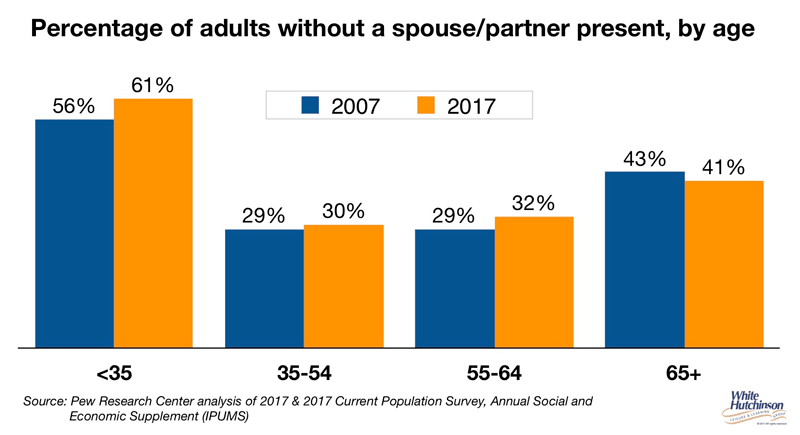
Vol. XVII, No. 8, December 2017
- Editor's corner
- More about the appeal of LTOs
- Unpartnered share of Americans on the increase
- Meet the conscientious consumer
- Ocean5 and Table 47 about to raise the bar
- A shrinking young adult market
- The importance of great designed spaces
- Out-of-home entertainment expenditures on the increase
- It's no longer about entertainment; it's all about the experience
- The marriage of food and entertainment
- Outdoor attractions are solid FEC profit centers
- Wake up at dawn to dance at this new rave
- Households with children on a downward slope
- New CLVs worth noting
Unpartnered share of Americans on the increase
The share of U.S. adults living without a spouse or partner has climbed from 39% in 2007 to 42% in 2017. Two important demographic trends have influenced this phenomenon. The share of adults who are married has fallen, while the share living with a romantic partner has grown. However, the increase in cohabitation has not been large enough to offset the decline in marriage, giving rise in the number of “unpartnered” Americans.
The median household income for partnered adults, either married or cohabiting, is $86,000. By contrast, the median household income for unpartnered adults is roughly $61,000.
Demographics have an influence. Adults with at least a bachelor's degree are significantly less likely to be unpartnered (31%) than less-educated adults (46%). In 2017, 51% of working-age adults without a job were not living with a spouse or partner. Among employed working-age adults, the share that were unpartnered is much less at 38%.
Almost six-in-ten unpartnered adults (58%) have never been married. About one fifth of unpartnered adults (21%) are divorced, 14% are widowed, and the remainder are either separated or married without a spouse present in the household.

Implications for CLVs
Single young adults (under age 35) are now over six of every ten young adults (61%). They are a growing demographic to target.
Vol. XVII, No. 8, December 2017
- Editor's corner
- More about the appeal of LTOs
- Unpartnered share of Americans on the increase
- Meet the conscientious consumer
- Ocean5 and Table 47 about to raise the bar
- A shrinking young adult market
- The importance of great designed spaces
- Out-of-home entertainment expenditures on the increase
- It's no longer about entertainment; it's all about the experience
- The marriage of food and entertainment
- Outdoor attractions are solid FEC profit centers
- Wake up at dawn to dance at this new rave
- Households with children on a downward slope
- New CLVs worth noting


